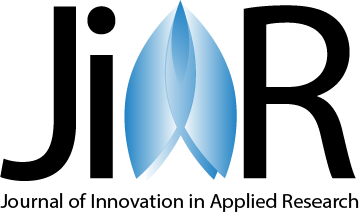
Decolourization of Textile Dye by Bacteria Isolated from Ganges Water Near Cossipore Region, Kolkata
18
Views
30
Downloads
Increasing environmental pollution due to improper disposal of industrial waste has created an upsurge for the development of ecofriendly and cost-effective methods of waste removal. Synthetic dyes discharged by textile industries, paper mills, plastic industries have been serving as potential pollutants to the soil and water bodies. Conventional physicochemical processes for dye decolorization are expensive and consequently generate secondary pollution due to the production of significant number of toxic derivatives. Hence, development of cheaper and environment friendly method has always drawn the attention of the researchers. The present investigation provides an insight on the role of bacteria in the detoxification of synthetic dyes. The study documented the role of nine bacterial isolates in decolorization of different dyes (malachite green, crystal violet, congo red, nigrosin and safranin). The isolates have shown best results in the degradation of malachite green and crystal violet. Presence of secretory amylase and laccase enzymes was also assessed biochemically.
Industrialization and rapid urbanization have become an inevitable mean of progress for a developing country in recent scenario but regrettably this imparts a huge threat to our environment. Textile industries, like many other industries continuously discharge industrial effluents containing synthetic dyes and toxic heavy metals into aquatic bodies, estuaries and landfills. These synthetic dyes are recalcitrant and serve as xenobiotic compounds (Pandey et al., 2007). Inappropriate disposal of industrial effluents in natural resources like soil and water causes serious toxicity to the aquatic and terrestrial life. Approximately 1,00,000 different dyes are regularly used in different textile industries (Das and Mishra, 2017) which include azo, anthraquinone, thalocyanine, triphenylmethane and triarylmethane dyes. These dyes contain electron withdrawing groups which create electron deficiency in them. This aids difficulty in scavenging the dyes by the natural processes and the leftover residues cause serious deterioration of soil, water and other habitats by causing toxicity and carcinogenicity (Kaur et al., 2010). Hence, removal of these potential pollutants has become an exigency to restore the ecological niche of a habitat. Bioremediation or phytoremediation both have been proved to be better means over the conventional processes as they are cost effective and do not render toxicity. Physicochemical dye removal processes generally utilize filtration, coagulation, use of activated carbon, flocculation etc. all of which are very expensive and produces wastes that (Olukanni et al., 2006; Verma et al., 2012) may also lead to secondary level of pollution (Shah, 2013). Dye decolourization by microorganisms have been extensively demonstrated in past few decades and showed considerable potential in bioremediation process in an eco-friendly manner (Kalyani et al., 2009). As evidenced from a number of studies, bacteria, yeast, fungi produce various extracellular enzymes like laccase, lignin peroxidase, azo reductase, hemeperoxidase, manganese peroxidase exhibiting dye decolourization ability (Das and Ghatak, 2019). A number of studies have established the role of laccase in microbial dye decolourization process (Mani et al., 2019). Bacteria and fungi utilize these enzymes for the reduction of the dyes to get nutrient and energy source thereby converting the dyes into non-toxic forms (Pandey et al., 2007). The present study encompasses the role of microorganisms in decolourization of textile dyes. For this purpose, bacteria were isolated from Ganges water near the industrial region of Cossipore, Kolkata and bacterial isolates were used to study bio-decolourization of five different dyes namely Malachite Green, Crystal Violet, Congo Red, Safranin and Nigrosin. The study is aimed at determining an alternative to the conventional dye degradation method.
<?xml version="1.0" encoding="UTF-8" standalone="yes"?>
<!DOCTYPE article PUBLIC "-//NLM//DTD JATS (Z39.96) Journal Publishing DTD v1.2d1 20170631//EN" "JATS-journalpublishing1.dtd">
<article xlink="http://www.w3.org/1999/xlink" dtd-version="1.0" article-type="environmental-biotechnology" lang="en">
<front>
<journal-meta>
<journal-id journal-id-type="publisher">JIAR</journal-id>
<journal-id journal-id-type="nlm-ta">Journ of innovation in applied research</journal-id>
<journal-title-group>
<journal-title>Journal of Innovation in Applied Research</journal-title>
<abbrev-journal-title abbrev-type="pubmed">Journ of innovation in applied research</abbrev-journal-title>
</journal-title-group>
<issn pub-type="ppub">2231-2196</issn>
<issn pub-type="opub">0975-5241</issn>
<publisher>
<publisher-name>Radiance Research Academy</publisher-name>
</publisher>
</journal-meta>
<article-meta>
<article-id pub-id-type="publisher-id">45</article-id>
<article-id pub-id-type="doi"> 10.51323/JIAR.4.1.2021.23-29</article-id>
<article-id pub-id-type="doi-url"/>
<article-categories>
<subj-group subj-group-type="heading">
<subject>Environmental Biotechnology</subject>
</subj-group>
</article-categories>
<title-group>
<article-title>Decolourization of Textile Dye by Bacteria Isolated from Ganges Water Near Cossipore Region, Kolkata
</article-title>
</title-group>
<contrib-group>
<contrib contrib-type="author">
<name>
<surname>Ghatak</surname>
<given-names>Anamika</given-names>
</name>
</contrib>
<contrib contrib-type="author">
<name>
<surname>Das</surname>
<given-names>Suchismita</given-names>
</name>
</contrib>
<contrib contrib-type="author">
<name>
<surname>Ghosh</surname>
<given-names>Shonima Talapatra</given-names>
</name>
</contrib>
</contrib-group>
<pub-date pub-type="ppub">
<day>1</day>
<month>01</month>
<year>1970</year>
</pub-date>
<volume>4</volume>
<issue/>
<fpage>23</fpage>
<lpage>29</lpage>
<permissions>
<license license-type="open-access" href="http://creativecommons.org/licenses/by/4.0/">
<license-p>This is an open-access article distributed under the terms of the Creative Commons Attribution (CC BY 4.0) Licence. You may share and adapt the material, but must give appropriate credit to the source, provide a link to the licence, and indicate if changes were made.</license-p>
</license>
</permissions>
<abstract>
<p>Increasing environmental pollution due to improper disposal of industrial waste has created an upsurge for the development of ecofriendly and cost-effective methods of waste removal. Synthetic dyes discharged by textile industries, paper mills, plastic industries have been serving as potential pollutants to the soil and water bodies. Conventional physicochemical processes for dye decolorization are expensive and consequently generate secondary pollution due to the production of significant number of toxic derivatives. Hence, development of cheaper and environment friendly method has always drawn the attention of the researchers. The present investigation provides an insight on the role of bacteria in the detoxification of synthetic dyes. The study documented the role of nine bacterial isolates in decolorization of different dyes (malachite green, crystal violet, congo red, nigrosin and safranin). The isolates have shown best results in the degradation of malachite green and crystal violet. Presence of secretory amylase and laccase enzymes was also assessed biochemically.
</p>
</abstract>
<kwd-group>
<kwd>Bioremediation</kwd>
<kwd>Dye decolorization</kwd>
<kwd>Malachite Green</kwd>
<kwd> Crystal Violet</kwd>
<kwd>Congo Red </kwd>
<kwd>Ganga</kwd>
</kwd-group>
</article-meta>
</front>
</article>
Department of Microbiology, Tara Devi Harakh Chand Kankaria Jain College, 6, Ram Gopal Ghosh Road, Cossipore, Kolkata 700002, India